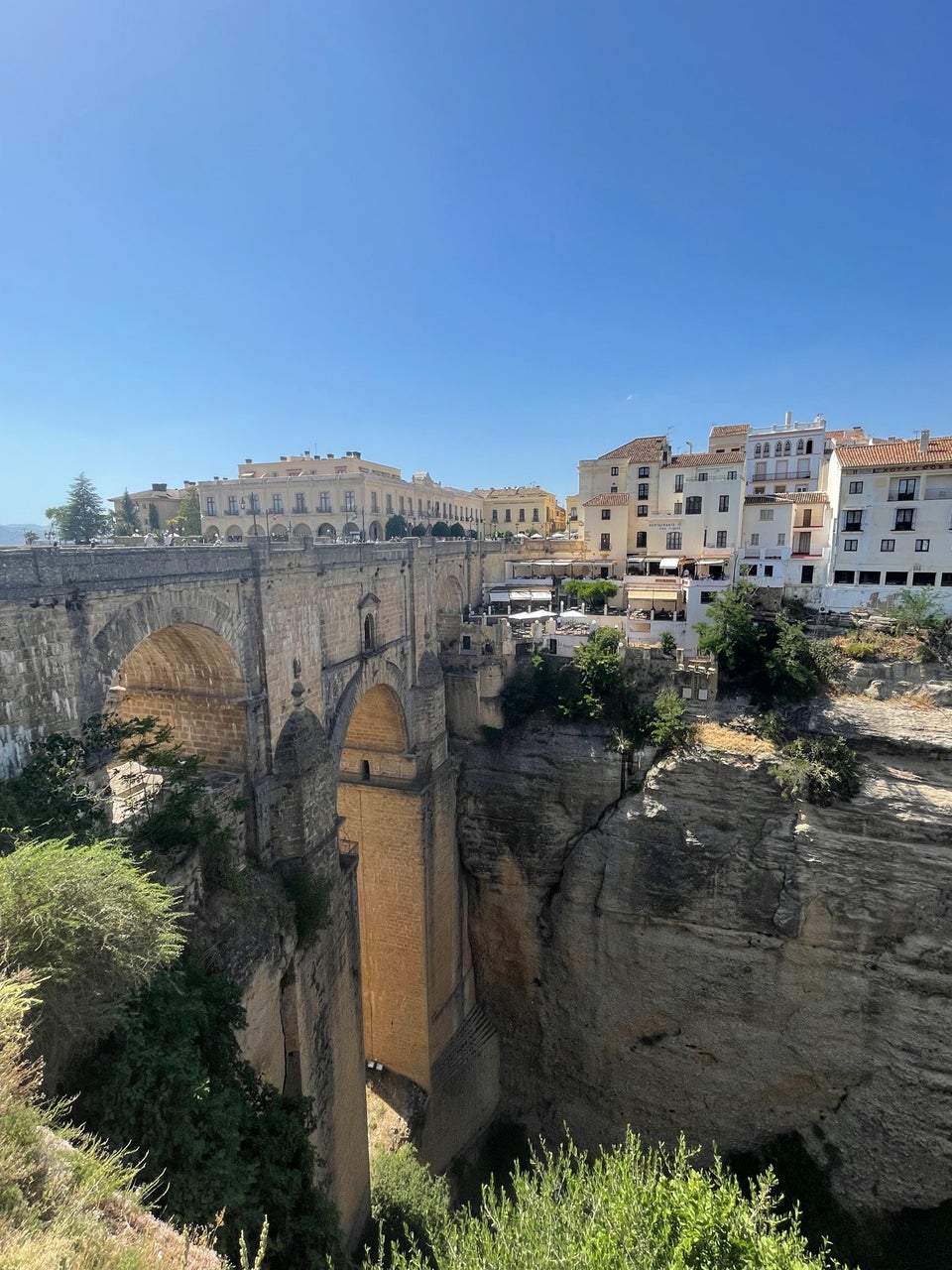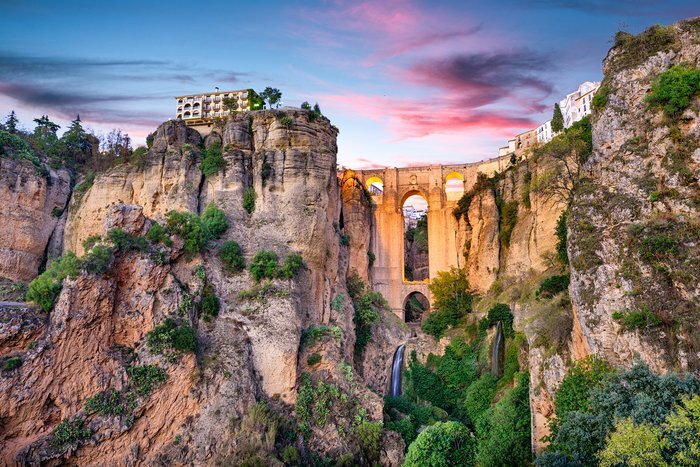Nestled in the heart of Andalusia in Malaga Province, Spain, Ronda sits high in the mountains at an elevation of about 750 meters (2,460 feet) above sea level. Known for its breathtaking vistas and unique geography, the Guadalevin River divides Ronda, carving out the dramatic El Tajo Canyon with cliffs that plunge nearly 100 meters deep. The city’s spectacular cliffside views and sweeping panoramas make it a must-visit destination for travelers from around the globe.
Ancient Roots and Strategic Importance
Founded by the Celts in the 6th century BC, Ronda has been shaped by many cultures over the centuries. It later became a strategic fortress under Roman rule, with Julius Caesar himself reportedly investing in its fortifications. The city continued to thrive during the Visigoth period until 713 AD, when the Moors conquered it. They renamed it Izn-Rand Onda, meaning “city of the castle,” and established it as the capital of the Takurunna Province. Under Moorish rule, Ronda grew into an important center for administration, culture, and trade. The city remained under Moorish influence until the 15th century, when it was reclaimed by Spain, marking the beginning of a new chapter in its history.

Ronda: A Crossroads of Civilizations
The fusion of different cultures and civilizations over the centuries has given Ronda a unique character. From the Celts to the Romans, Visigoths, Moors, and Spanish, each group left their mark on the city’s architecture, culture, and identity. This rich historical tapestry has made Ronda one of Spain’s most historically significant cities, as it has witnessed the ebb and flow of various empires and cultures.
Architectural Highlights: Bridges and Buildings
Ronda’s El Tajo Canyon is not just a natural wonder; it is home to some of the city’s most iconic structures, including its three historic bridges. The Puente Romano (also known as the Puente San Miguel) is the oldest of these, dating back to Roman times. Its stone arches span the gorge, offering a glimpse into Ronda’s ancient past. However, the Puente Nuevo (New Bridge), completed in the 18th century, is perhaps Ronda’s most famous and visually striking landmark. Rising nearly 120 meters above the canyon floor, the Puente Nuevo connects the old and new parts of the city, providing stunning views of the gorge and the surrounding mountains. The Puente Viejo (Old Bridge), from the Moorish era, adds to the city’s architectural diversity, showcasing Ronda’s long history of cultural exchange.

A Testament to Engineering and Aesthetics
The bridges are not only functional but also serve as works of engineering marvels. The construction of these bridges required immense skill and vision, and their preservation today allows visitors to appreciate the ingenuity of ancient and early modern builders. These structures stand as symbols of Ronda’s resilience and importance as a strategic location in history.
Moorish and Renaissance Influence
Ronda’s streets are lined with a captivating blend of Moorish and Renaissance architecture, reflecting its diverse historical influences. The town’s whitewashed houses, narrow alleys, and intricate tile work are remnants of its Islamic heritage, which dominated Ronda for centuries. One of the best examples of Moorish architecture in Ronda is the Palacio de Mondragón. This elegant palace, now a museum, offers a window into the city’s past, with beautiful courtyards and a collection of artifacts that tell the story of Ronda’s various rulers. Another notable site is La Casa del Rey Moro (The House of the Moorish King), an imposing building that features a staircase descending into the gorge, leading to an intriguing water mine that was used for defense during the city’s Islamic period.

Renaissance Splendor Amidst the Ancient
The Spanish Renaissance left its mark on Ronda as well, particularly in the form of grand buildings such as the Church of Santa Maria la Mayor, which was built on the site of a former mosque. The mix of Moorish and Renaissance influences creates a visually stunning contrast, giving Ronda a distinct architectural character that’s unlike any other city in Andalusia.
Preserving Andalusian Culture and Cuisine
Ronda is not only a city of historical and architectural significance but also a vibrant hub of Andalusian culture. Traditional flamenco performances and festivals add to the town’s lively atmosphere, while its culinary scene is a true reflection of the region’s rich food heritage. Local specialties like rabo de toro (oxtail stew), tapas, and locally produced wines provide a delicious taste of Andalusia.

One of the town’s most notable cultural landmarks is the Plaza de Toros de Ronda, one of the oldest bullrings in Spain. Built in the 18th century, the bullring is still in use today and remains an integral part of Ronda’s cultural identity. Bullfighting, or tauromachia, is a traditional Spanish art that has influenced the country’s culture for centuries, and Ronda stands as a center of its history and practice.
A Culinary and Cultural Experience
Visitors to Ronda can enjoy both the rich flavors of Andalusian cuisine and the deep cultural significance of bullfighting. The town offers an immersive experience in both, allowing guests to appreciate the region’s vibrant culture while indulging in its famous dishes.
Gateway to Andalusia’s White Villages
Ronda serves as an ideal base for exploring the stunning pueblos blancos (white villages) of Andalusia. These picturesque villages, with their charming whitewashed buildings and narrow, winding streets, offer a glimpse into traditional Andalusian life. Each village has its own unique charm, with stunning views, local crafts, and rich cultural traditions. The surrounding Sierra de Grazalema and Sierra de las Nieves mountain ranges offer a paradise for hikers, with trails through dramatic landscapes filled with lush greenery, wildflowers, and hidden springs.

Exploring the Heart of Rural Andalusia
The pueblos blancos are a treasure trove of history and culture, with each village offering its own unique set of experiences, from exploring ancient castles to discovering local art. Ronda’s proximity to these villages makes it an ideal starting point for anyone wishing to experience the authenticity of rural Andalusia.
An Enduring Legacy
Today, Ronda remains a living museum of Southern Spain’s layered history. The city preserves its ancient, Islamic, and Spanish Renaissance architectural elements, making it a cultural treasure. Visitors are not only captivated by its stunning landscapes but also by the deep historical significance embedded in its buildings, bridges, and streets. The city’s ability to merge historical and natural beauty makes it a unique destination in Spain.
A Timeless Experience
Ronda offers an experience that’s both deeply rooted in the past and timelessly beautiful. From its ancient bridges to its charming streets, Ronda is a place where history, culture, and natural beauty coexist in perfect harmony. It is a testament to the enduring legacy of Andalusia, making it one of Spain’s most unforgettable destinations.
With its awe-inspiring landscapes, rich history, and authentic Andalusian atmosphere, Ronda continues to be a cultural and historical jewel in the heart of Andalusia.

